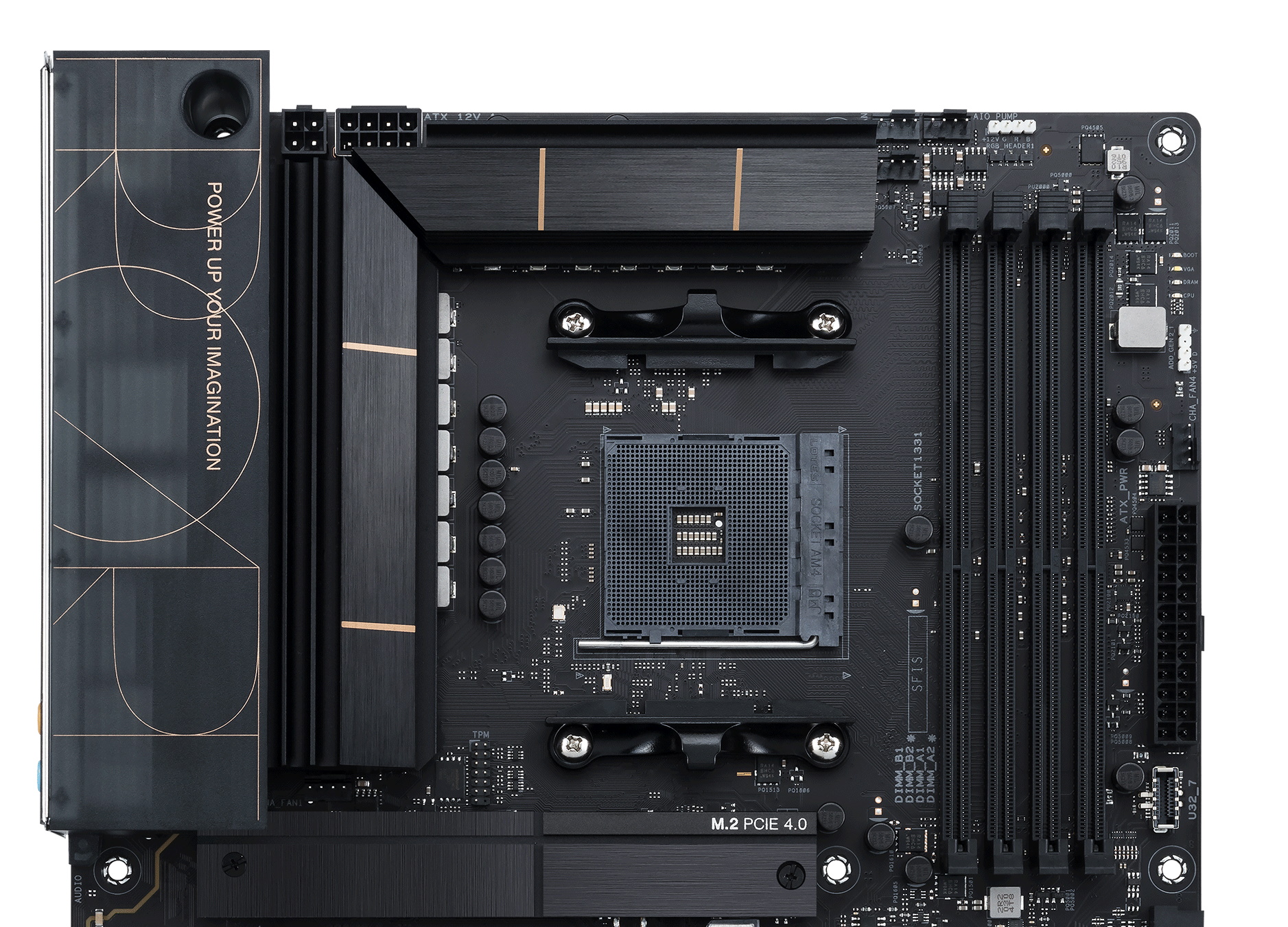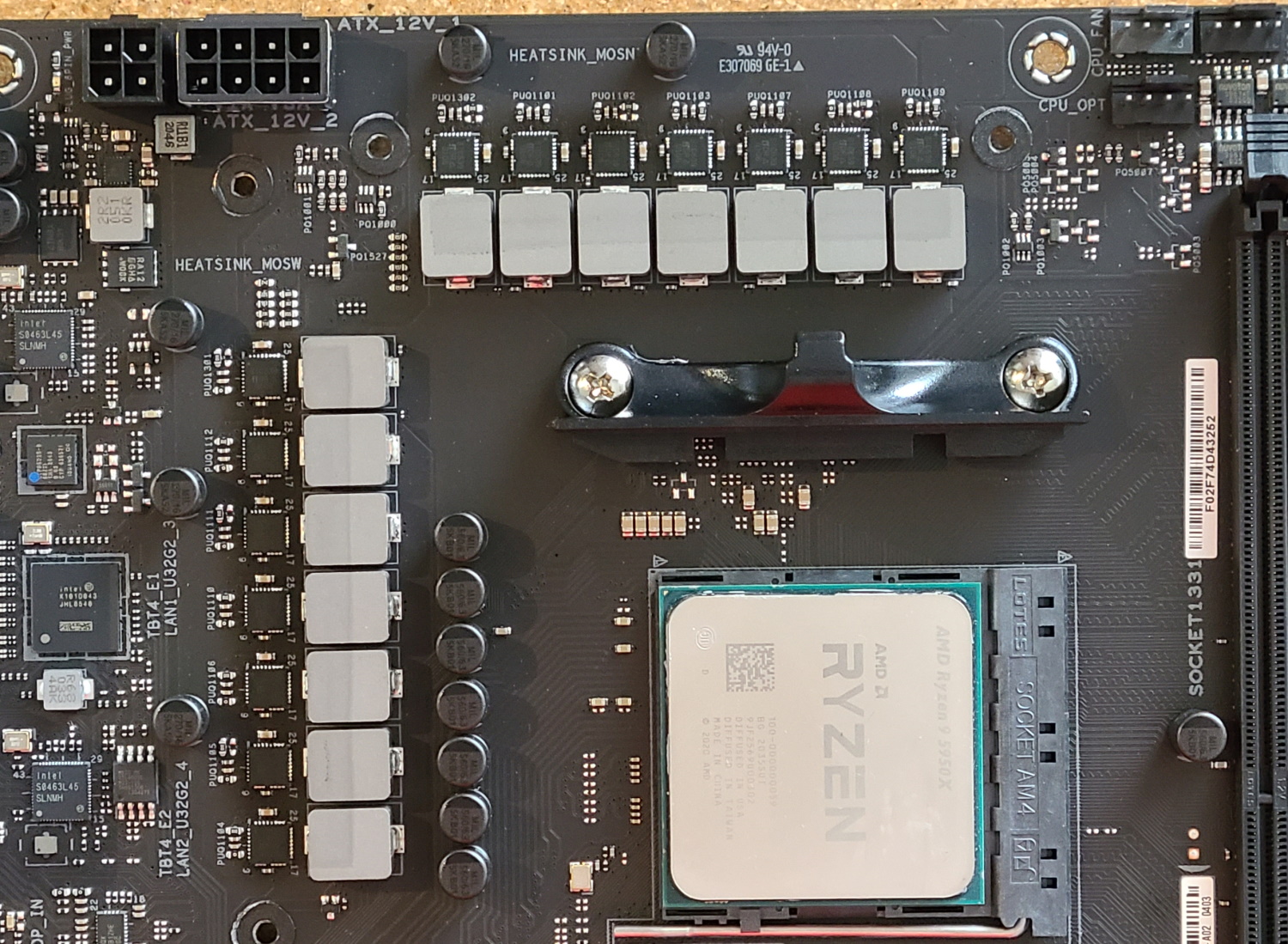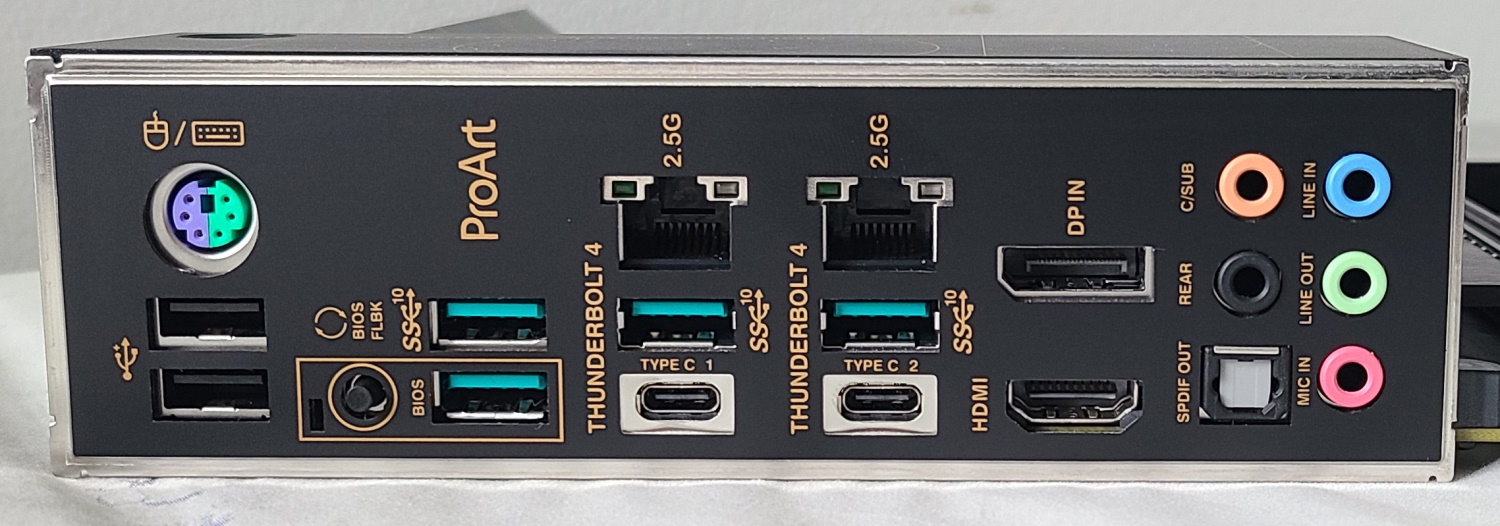Tom's Hardware Verdict
The $299.99 Asus ProArt B550 Creator includes dual M.2 sockets, 8 USB ports on the rear IO (including two TB4 Type-C ports), dual 2.5 GbE, and an appearance that fits in with most build themes. If you’re looking for Thunderbolt 4 ports for ultra-fast transfer or enhanced video outputs, the Creator is worth a look.
Pros
- +
+ 2x Thunderbolt 4 Type-C ports
- +
+ Unique integrated M.2 latches
- +
+ Dual 2.5 GbE ports
Cons
- -
Only two M.2 sockets and four SATA ports
- -
Wi-Fi not included
Why you can trust Tom's Hardware
The Asus ProArt B550 Creator is, as the name implies, designed with the content creator in mind. It sports dual Thunderbolt 4 ports (still a rarity among AMD boards), DisplayPort input, dual 2.5 GbE, as well a VRM capable of supporting our Ryzen 9 5950X CPU at stock and while overclocked. While looks aren’t at the top of the list, the board’s black color and gold accents fit in with most build themes, but aren’t likely a focal point considering the lack of RGB lighting.
At $299.99 from Newegg, the ProArt B550 Creator is a mid-range board that offers many features at a price that won’t leave your wallet empty. The Creator includes four SATA ports and memory support listed to DDR4 4866+(OC). It also has a premium audio codec in the Realtek ALC1220A. It’s a well-rounded board overall, with a focus on creators and professionals, but it still works well for more general users.
In our performance testing, the B550 Creator was average. In some tests it did well, including compression and PCMark. However, in tests like Cinebench and the multi-core testing in POV-Ray, it was on the slower side of average. No scores were alarmingly out of line, but the board held our CPU back a bit out of the box. It is made for work more so than overclocking, so being a bit tighter is expected. It’s nothing some tweaking can’t resolve, but worth noting nonetheless.
We were able to overclock our Ryzen 9 5950X to 4.4 GHz, setting 1.3V in the BIOS without issue. Overclocking is limited by your cooler and not the board, which is ideal. While I certainly wouldn’t use sub-ambient cooling here, the VRM is plenty capable. We were also able to run all 32GB of memory at DDR4 3600 at a 1:1 ratio, which bodes well for performance for those creators who need lots of fast RAM. Read on for more details on the features and see if the ProArt B550 Creator earns a spot on our best AMD motherboards list.
Specifications - Asus ProArt B550 Creator
| Socket | AM4 |
| Chipset | B550 |
| Form Factor | ATX |
| Voltage Regulator | 12 Phase (12+2, 50A MOSFETs for Vcore) |
| Video Ports | (1) HDMI (v2.1) |
| Row 5 - Cell 0 | (2) Thunderbolt 4 USB Type-C |
| Row 6 - Cell 0 | (1) DisplayPort (v1.2, input for TB4 ports) |
| USB Ports | (2) Thunderbolt 4, Type-C (40 Gbps) |
| Row 8 - Cell 0 | (4) USB 3.2 Gen 2, Type-A (10 Gbps) |
| Row 9 - Cell 0 | (2) USB 2.0 (480 Mbps) |
| Network Jacks | (2) 2.5 GbE |
| Audio Jacks | (5) Analog + SPDIF |
| Legacy Ports/Jacks | PS/2 |
| Other Ports/Jack | ✗ |
| PCIe x16 | (2) v4.0 (x16, x8/x8) |
| Row 15 - Cell 0 | (1) v3.0 (x4) |
| PCIe x8 | ✗ |
| PCIe x4 | ✗ |
| PCIe x1 | (2) v3.0 (x1) |
| CrossFire/SLI | AMD 3-Way/2-Way CrossfireX |
| DIMM slots | (4) DDR4 4866+(OC), 128GB Capacity |
| M.2 slots | (1) PCIe 4.0 x4 (64 Gbps) / PCIe + SATA (up to 110mm) |
| Row 22 - Cell 0 | (1) PCIe 3.0 x4 (32 Gbps) / PCIe + SATA (up to 110mm) |
| U.2 Ports | ✗ |
| SATA Ports | (4) SATA3 6 Gbps (RAID 0, 1 and 10) |
| USB Headers | (1) USB v3.2 Gen 2, Type-C (10 Gbps) |
| Row 26 - Cell 0 | (1) USB v3.2 Gen 1 (5 Gbps) |
| Row 27 - Cell 0 | (2) USB v2.0 (480 Mbps) |
| Fan/Pump Headers | (7) 4-Pin |
| RGB Headers | (2) aRGB (3-pin) |
| Row 30 - Cell 0 | (2) RGB (4-pin) |
| Legacy Interfaces | ✗ |
| Other Interfaces | FP-Audio |
| Diagnostics Panel | Post Status Checker (4 LEDs) |
| Internal Button/Switch | ✗ |
| SATA Controllers | ✗ |
| Ethernet Controller(s) | Intel I225-V (2.5 Gbps) |
| Wi-Fi / Bluetooth | ✗ |
| USB Controllers | ✗ |
| HD Audio Codec | Realtek ALC1220A |
| DDL/DTS Connect | ✗ / ✗ |
| Warranty | 3 Years |
Opening up the box, along with the motherboard, we find a set of accessories designed to get your PC up and running without a trip to the store. Asus includes a couple of SATA cables and a DisplayPort-to-DisplayPort cable, along with your typical M.2 screws and support media. Below is a list of all included accessories.
- (2) SATA cables
- DP to DP cable (for TB4)
- M.2 rubber package
- Installation media
- User manual
- Support/Driver CD
- ACC Express Activation key card
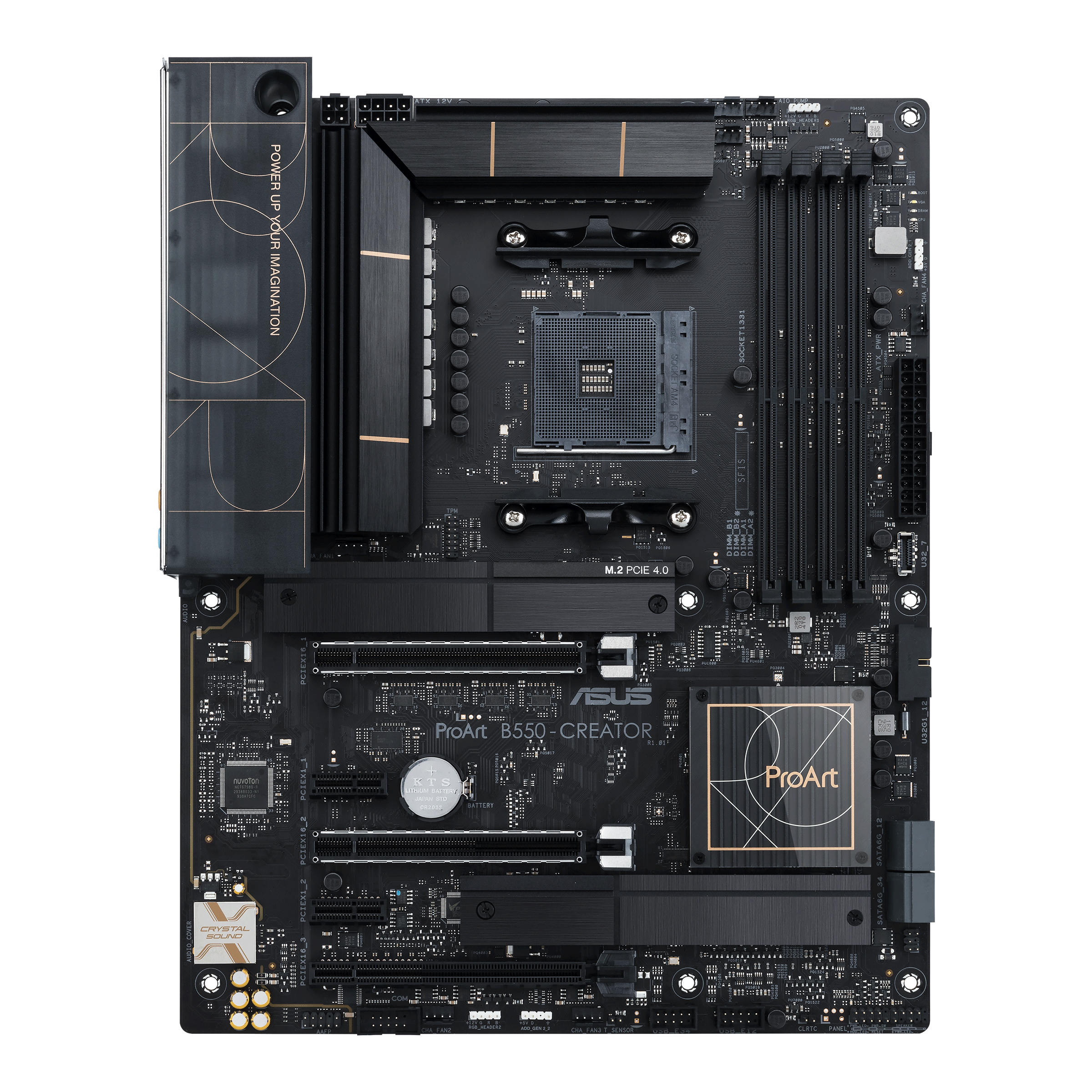
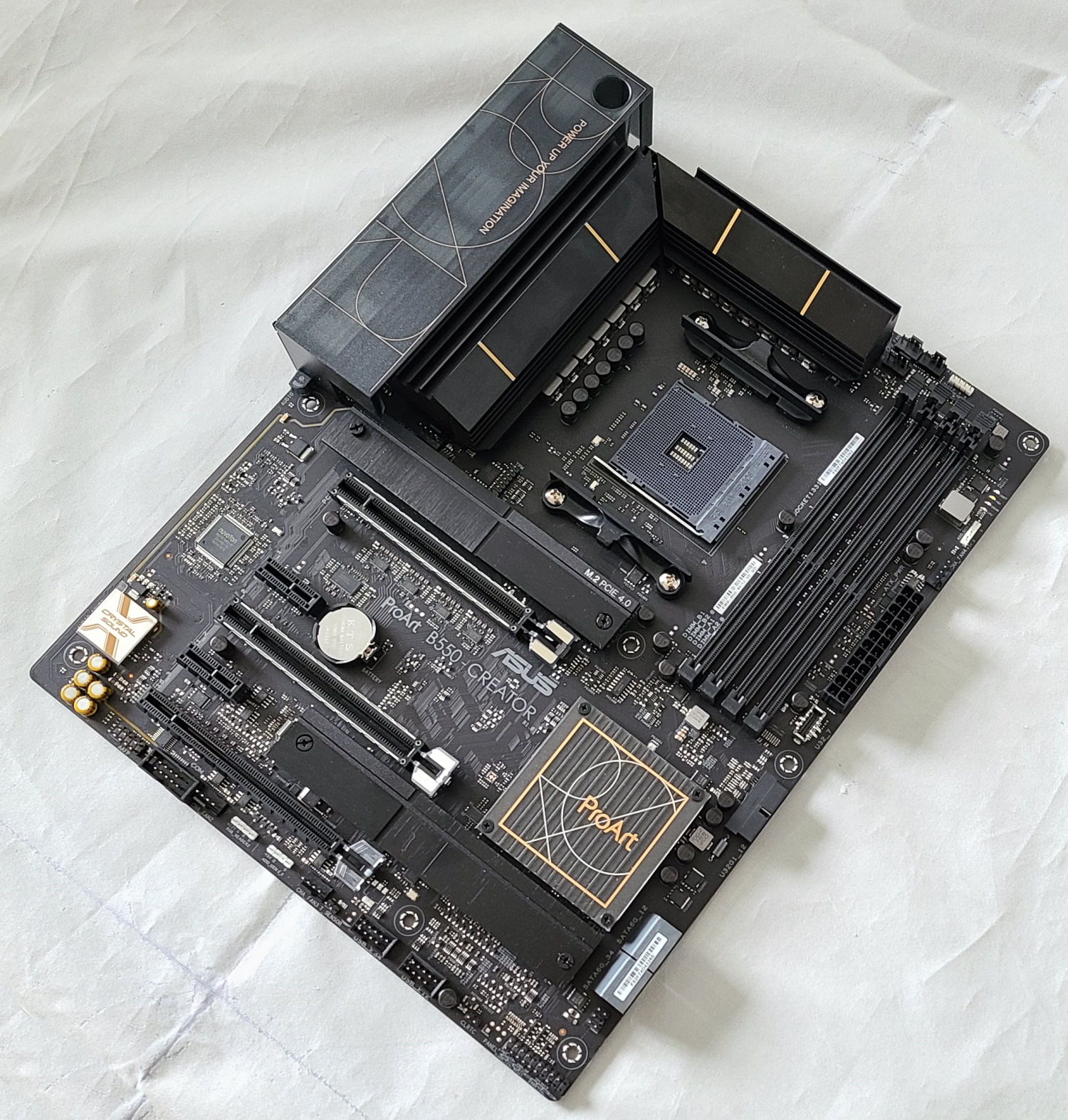
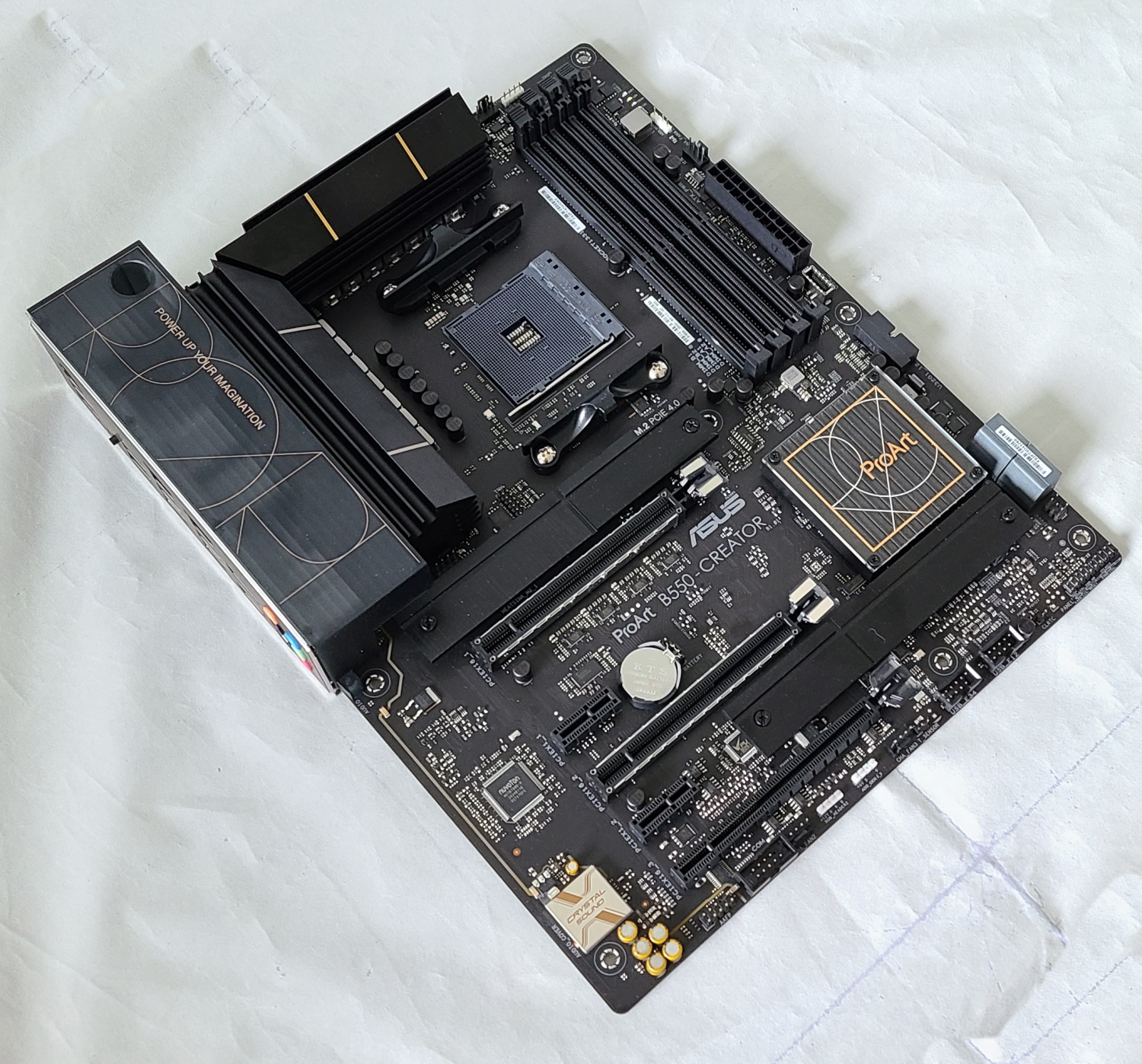
Looking at the B550 Creator closely for the first time, we see a matte-black board with oversized black VRM heatsinks and gold highlights. The chipset sports a clear plexi top, with the ProArt branding on top. The VRM heatsinks and IO cover also sport gold highlights. The board includes slot reinforcement for two PCIe sockets, but the RAM sockets are bare. If you’re looking for integrated RGB lighting, you’ll have to use the onboard headers, as the board doesn’t include native RGBs. Overall, the ProArt B550 Creator looks like a ‘creator’ type board with more function over form. That said, it won’t detract from the look of your build. But it won’t be a focal point either.
Starting at the top half of the board, we get a closer look at the large VRM heatsinks and notice the smoked translucent IO cover. There are two EPS power connectors in the top left corner to power the CPU: one required 8-pin and an optional 4-pin.
Get Tom's Hardware's best news and in-depth reviews, straight to your inbox.
To the right of the CPU socket, on the top edge of the boardm are the first three (of seven) 4-pin fan headers. Each header supports output up to 1A/12W and controls both DC and PWM fans. While there are plenty of headers, I would like to see at least one that outputs more than 12W, as that limits the choice of pump and number of fans. Worth noting: The AIO pump header runs at full speed. Just to the right of these is the first RGB header, in this case a 4-pin RGB. The others are scattered around the board.
Below these few headers are the four single-side locking RAM slots. The board supports up to 128GB of RAM with speeds listed up to DDR4 4866+(OC) when using a 5000 series processor. Along the right edge and working our way down the board, we come across the Q-LEDs that tell you where the board is in the POST process. If there is a problem in any of these steps (Boot, VGA, RAM or CPU), that specific LED remains lit up, notifying you where the problem is. Since there isn’t a 2-character post code LED, this is a good value-add for troubleshooting POST/boot issues.
Below these is another RGB header (3-pin ARGB), a chassis fan header, the 24-pin ATX connector to power the board, and finally, a front-panel USB 3.2 Gen2 Type-C header.
Moving on to the VRM, Asus strapped a 14-phase (12+2) configuration on to the B550 Creator. Power is sent from the EPS connectors to the Asus Digi EPU chip (ASP1106JGQW) six-channel controller for Vcore. Power then goes through the 50A Vishay Sic639 MOSFETs. In this case, three are teamed together from one signal for Vcore. The 600A available to the CPU isn’t the most we’ve seen with this class of board. However, it proved to be plenty for stock and overclocked operations, and the large VRM heatsinks kept things running well within specification.
Next is the bottom of the board, where we find the audio bits, PCIe and M.2 storage and more. Starting on the left side, we see a faraday cage labeled Crystal Sound, covering the Realtek ALC1220 codec. along with the common audio separation line running up the edge. Surrounding the codec are several audio caps. Although this isn’t the latest and greatest audio chip available, an overwhelming majority should find this solution acceptable.
In the middle of the board are three full-length PCIe slots and two PCIe x1 slots. The two for video cards are reinforced to help prevent shearing from heavy video cards and protects against EMI. These slots are both fed from the CPU and PCIe 4.0 capable. The top slot runs at x16 and the bottom maxes at x8. When both slots are in use, they break down to x8/x8, supporting AMD CrossfireX multi-GPU only (no SLI is listed, even though the lane breakdown supports it).
The bottom full-length slot is PCIe 3.0 x4 and shares bandwidth with the Thunderbolt ports. If the slot is populated, Thunderbolt will have no output. The small PCIe slots source their lanes from the chipset, running PCIe 3.0 x1 speeds sharing bandwidth with M.2_2. In the BIOS. You can change the settings of this M.2 socket to x4 (default) or x2 to allow both the slot and socket to work, albeit with limited bandwidth. What’s unique about these is the latching mechanism. Gone are the tiny screws that are a pain to get on without dropping in the case or the carpet. Instead you get pre-mounted latches that simply twist over the M.2 modulem holding it in place. I’d like to see this feature on all boards as it makes it way easier to install and remove drives.
Located on top of the primary PCIe slot is the first (of two) M.2 sockets. This socket supports PCIe 4.0 x4 and SATA modes using up to a 110mm module. The second slot, located below the chipset heatsink, also supports both SATA- and PCIe-based modules. However, this socket is connected via the chipset and supports a maximum of PCIe 3.0 x4 speeds. I would like to have seen a third M.2 socket on the board, as fast storage is critical for many creators. That said, the B550 platform just doesn’t have enough lanes to go around between Thunderbolt, storage, and PCIe lanes. If you need morem as well as Thunderbolt connectivity, you’ll have to look at X570-based motherboards or, of course, opt for an Intel platform where Thunderbolt is more common.
Continuing right, we’ll skip over the chipset heatsink and start on the right edge. Here we see a horizontal front panel USB 3.2 Gen1 port and four SATA ports oriented the same way. In total, you can run four SATA drives and two M.2 drives of any type together.
Across the bottom are several headers, including USB ports and RGB headers. Here’s the complete list, from left to right:
- Front panel audio
- COM header
- Chassis fan header
- (2) RGB headers (aRGB and RGB)
- Chassis fan header
- 2-pin Temperature sensor
- (2) USB 2.0 headers
- Clear CMOS jumper
- Front panel
As we shift focus around to the rearIO, we see a black pre-installed IO plate that matches the board’s theme. From left to right, we spy a legacy PS/2 port, and below it two USB 2.0 ports. To the right are four USB 3.2 Gen2 ports (teal) along with a BIOS Flashback button. Below this are the two Thunderbolt4 USB Type-C ports, while above those are the two Intel I225-V Ethernet ports. Continuing right, we run into a DisplayPort input (for use with TB4 ports/video) along with an HDMI (v2.1) output. Finally, on the far right is the 5-plug plus SPDIF audio stack.
MORE: Best Motherboards
MORE: How To Choose A Motherboard
MORE: All Motherboard Content

Joe Shields is a staff writer at Tom’s Hardware. He reviews motherboards and PC components.
-
HideOut dual thunderbolt is NOT worth $125. You can find boards with one 2.5g and more sata and such WITH 12xx autio for $150 all day. If you want more LAN bandwidth you can get all that + 10gb ethernet for alot less too, and get more M2 ports and sata ports. This board makes no sense to me.Reply
Here is a very overpriced add-in card you can use for dual Tbolt 4, even from Asus. https://www.newegg.com/asus-90mc09p0-m0aay0-pci-express-to-thunderbolt/p/N82E16815293048?Description=thunderbolt&cm_re=thunderbolt-_-15-293-048-_-Product&quicklink=true -
tek-check I own this motherboard for 4 months now and it works pretty reliably so far. There is no good reason to complain about not having third M.2 slot, as B550 platform has set amount of available PCIe lanes. Besides, one can always purchase higher capacity NVMe storage to meet their needs on two slots. Simple. Less e-waste and plastic for packaging.Reply
Designers of the board maxed out on connectivity, working with what is available. Well done to them. Two TB4 ports use x4 PCIe 3.0 lanes and bring more versatility than having another M.2 slot. Super fast external storage can be attached at any time, such as TB3 NAS/DAS, plus display, plus TB docking station, plus 10 GbE networking, etc. Plenty of options. How much more one could possibly want with B550?
For those who stubbornly desire third M.2 slot, this board is flexible enough in configuration and you have additional two options: use x4 PCIe 3.0 slot on the chipset for expansion card with NVMe drive (this turns off TB4) or use x8 PCIe 4.0 second GPU slot to attach two NVMe 4.0 drives. Suddenly, you can have 3 NVMe 4.0 drives and 1 NVMe 3.0. Not enough? Leaving GPU to operate in the first x8 PCIe 4.0 slot will be just fine. GPUs still cannot saturate fully x16 PCIe 3.0 bandwidth, so it will work fine in x8 PCIe 4.0 slot with the same bandwidth as x16 PCIe 3.0. Testing GPUs in x8 PCIe 4.0 vs. x16 PCIe 4.0 slot showed negligible difference. Higly recommended motherboard. -
Spanky Deluxe I've been using this board for a couple of months now and it's been great. The only issue I had was that screen sharing in Discord would cause all my USB ports to stop working - an issue with the B550 chipset that AMD had fixed via microcode for BIOS updates quite a while ago but for some reason the BIOS that ASUS sold the boards with (which came out after the AMD fixes) did not have the relevant microcode fixes. ASUS did finally release a BIOS update last month that let me fix the issue though.Reply
This board made complete sense to me as the add-in Thunderbolt cards are reportedly a bit flakey whereas the Thunderbolt support on this board is supposed to be rock solid. I don't currently use the Thunderbolt functionality but I'm going to be reconfiguring my home office within the next six months or so and I'm likely going to go hide the computer away in a hidden storage area at the other end of my office and so like the idea of using a Corning optical thunderbolt cable connected to a dock to connect my main devices. I just wanted that future proof functionality. -
tek-check Reply
I'd kindly request from Joe Shields to communicate to Asus and challenge them on the marketing claim that this motherboard hosts "HDMI 2.1" port on the back panel. They say, quote: "HDMI 2.1 (4K60)". "4K/60" is vague enough to be considered a feature specific to HDMI 2.1 spec.Admin said:The Asus ProArt B550 Creator offers dual Thunderbolt 4 Type-C and 2.5 GbE ports, along with a mid-range $299.99 price. If you can work with limited speedy internal storage, this is a solid option. Otherwise, the X570 platform may be a better choice due to the additional PCIe lanes/storage flexibility.
Asus ProArt B550 Creator Review: Designed for Pros, Works for Joes : Read more
4K/60 10/12-bit RGB image would qualify as HDMI 2.1 feature, becasue it requires more than 18 Gbps of bandwidth for transport and this can only be done with new FRL protocol introduced by HDMI 2.1 spec
4K/60 8-bit RGB can work over older TMDS protocol, which is standard HDMI 2.0b
So, not all "4K/60" signals are the same and can be delivered both by older TMDS protocol and newer FRL, depending on bit depth and required bandwidth.
I have challenged them twice via email and they have never answered my questions as regards to which specific features from HDMI 2.1 spec does this HDMI port support and how those features are anabled. One member of technical support team told me that the port supports older 1.4 spec speeds (10.2 Gbps), which is closer to truth on Vega platform.
There could be only two ways how HDMI 2.1 can work on a motherboard:
1. APU natively outputs FRL faster signal. FRL is core part of HDMI 2.1 spec
No current APU from AMD, including Ryzen 5000G series, support FRL signalling. Those APUs output HDMI signal by using older TMDS pixel clocks by Vega iGPU. By the way, Intel's CPUs neither have this capability.
2. APU is helped by additional level shifter/conversion chip DP 1.4-HDMI 2.1
Close shots of the motherboard in TechPowerUp review do not show that such chip is installed. So, has Asus installed a level shifter/converter HDMI 2.1 chip on this motherboard to enable FRL signals up to 40 or 48 Gbps? Can they answer this question, please?
If the motherboard does not have this enabling chip, Asus must remove "HDMI 2.1 (4K/60)" from marketing, as such claim would be meaningless and misleading the public. Whoever has this motherboard, please challenge them to provide with the evidence that this port can operate FRL protocol and deliver images with bandwidth above 18 Gbps. -
tek-check Reply
It is, so far. I run a display from one TB4 port, via DP-in from GPU, and use another port for various things, most recently for 10 GbE networking between two PCs at home.Spanky Deluxe said:Thunderbolt support on this board is supposed to be rock solid
The only thing people need to be aware of is that TB does not deliver FreeSync or VRR feature for gaming. Intel was supposed to work to enable this to work like on DisplayPort. -
PEJUman Reply
I have used TB3 AIC in the past, they all require a special connector (not sure for what) into a TB3 header in the motherboard.HideOut said:dual thunderbolt is NOT worth $125. You can find boards with one 2.5g and more sata and such WITH 12xx autio for $150 all day. If you want more LAN bandwidth you can get all that + 10gb ethernet for alot less too, and get more M2 ports and sata ports. This board makes no sense to me.
Here is a very overpriced add-in card you can use for dual Tbolt 4, even from Asus. https://www.newegg.com/asus-90mc09p0-m0aay0-pci-express-to-thunderbolt/p/N82E16815293048?Description=thunderbolt&cm_re=thunderbolt-_-15-293-048-_-Product&quicklink=true
This TB4 card also shows that cable still being used + "*Intel only 500 series MB compatibility..."
I wish I can just add this TB4 AIC card to any PCI-E 3.0 4x slot, but I am not 100% sure it'll work flawlessly without that special header connected. Which is my guess on why this B550 board is priced as a niche TB4 solution for AMD. -
tek-check Reply
It's not going to work properly.PEJUman said:I am not 100% sure it'll work flawlessly without that special header connected.
Because it is a niche. It's the first ever, and the only one at the moment, TB4 solution for AMD platfom. Latest, fastest connectivity solutions for Ryzen 5000, without all that heat and power consumption from Core CPUs. A breath of fresh air in motherboard line-up. My PC runs silently, even with heavier workloads on many cores.PEJUman said:Which is my guess on why this B550 board is priced as a niche TB4 solution for AMD.
Besides, many consumer electronics products are a bit pricier due to Covid disruption. There have been factories around the world closed for months and sourcing components has offen been a nightmare, let alone complications with shipping. Got this board on the first day when it arrived to local PC shop and never looked back. -
excalibur1814 "creators, that also works well for more general users"Reply
Years back you could just buy any motherboard/cpu, then get creating or gaming depending on your GPU. Those were simple days. Now you have to check if the board you're buying is a 'creator' model, a standard board, or both. I mean, it's just crazy now. Anyone would think that any board will allow you to do anything, realistically. Creator or standard!
/s -
deesider Reply
I like that idea too. It's just taken a long while for the available technology to make it possible without too many compromises.Spanky Deluxe said:This board made complete sense to me as the add-in Thunderbolt cards are reportedly a bit flakey whereas the Thunderbolt support on this board is supposed to be rock solid. I don't currently use the Thunderbolt functionality but I'm going to be reconfiguring my home office within the next six months or so and I'm likely going to go hide the computer away in a hidden storage area at the other end of my office and so like the idea of using a Corning optical thunderbolt cable connected to a dock to connect my main devices. I just wanted that future proof functionality.
